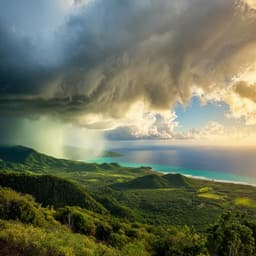
Earth Sciences
Observationally constrained projection of Afro-Asian monsoon precipitation
Z. Chen, T. Zhou, et al.
Explore the critical link between the future precipitation projections of the Afro-Asian summer monsoon and the current interhemispheric thermal contrast. This research by Ziming Chen, Tianjun Zhou, Xiaolong Chen, Wenxia Zhang, Lixia Zhang, Mingna Wu, and Liwei Zou provides insights that could significantly affect water resource management and flood risk in vulnerable regions like West Africa.
~3 min • Beginner • English
Introduction
The Afro-Asian monsoon system (West Africa, South Asia, East Asia) is crucial for freshwater resources for billions of people, yet projections of future summer monsoon precipitation from climate models show large inter-model spread, limiting reliability for adaptation and policy. Multi-model ensembles project increases in AfroASM precipitation under medium to high emissions, but with wide uncertainty driven strongly by dynamic circulation changes. Emergent constraint techniques link present-day observable variables to future projections to reduce spread. Building on evidence that AfroASM precipitation changes covary with interhemispheric thermal contrast (ITC) across time scales, the study hypothesizes that present-day ITC trends can constrain future AfroASM precipitation projections. The goal is to use observationally based constraints on ITC within a hierarchical statistical framework to reduce uncertainty and provide more reliable regional projections and implications for water availability.
Literature Review
Previous CMIP-based studies project AfroASM precipitation increases of roughly 8–14% (medium to high scenarios) but with large model spread (e.g., 1–25%). Thermodynamic moisture increases are robust, while dynamic circulation responses contribute most uncertainty. Model structural uncertainty accounts for over 70% of total uncertainty in CMIP5 long-term AfroASM projections. Emergent constraints have been applied to regional monsoons linking present-day SSTs and convection biases to future precipitation over East, South, and West Asia/Africa. In CMIP6, large regional uncertainty persists despite robust global land monsoon increases. Studies highlight the role of projected increases in ITC and land–sea thermal contrast in driving AfroASM uncertainty, suggesting a pathway for constraint. The linkage between ITC, equilibrium climate sensitivity (ECS), and monsoon circulation emphasizes how models with stronger NH–SH warming contrasts tend to project wetter monsoons.
Methodology
Data and models: Monthly outputs from 30 CMIP6 models were analyzed for historical simulations and future SSP5-8.5 projections (2050–2099) relative to 1965–2014; 18 CMIP6 models under SSP2-4.5 were also used for robustness. First realizations were used and fields regridded to 2.5°×2.5°. Internal variability contributions were estimated from 29 CMIP6 piControl simulations via 1000 synthetic 34-year trends per model. Observational temperature datasets: Berkeley Earth, Cowtan and Way v2, NASA GISTEMP v5, NOAA GlobalTemp v5; precipitation datasets: CRU TS, GPCC v7, CMAP v1201, GPCP v2.3.
Region and indices: Afro-Asian monsoon (AfroASM) region defined as land monsoon areas over Eurasia and North Africa where local summer minus winter precipitation exceeds 2.0 mm/day and summer exceeds 55% of annual (summer JJAS for NH). A circulation index was defined as vertical shear of zonal winds (200–850 hPa) averaged over 0–20°N, 30°W–120°E.
Inter-model EOF analysis: The leading mode (PC1) of inter-model uncertainty in JJAS precipitation change (SSP5-8.5, 2050–2099 minus 1965–2014) over AfroASM was obtained via inter-model EOF, with PCs normalized. Sensitivity tests scaling out each model’s mean change and variance confirmed robustness of the leading pattern.
Interhemispheric thermal contrast (ITC): ITC defined as area-mean surface temperature difference between 20°N–50°N and 20°S–50°S. A present-day ITC pattern index (1981–2014) was constructed by projecting each model’s surface temperature trend onto the PC1-associated historical warming pattern, separately in NH and SH, then taking their difference. Observational ITC was computed analogously from the four temperature datasets.
Physical linkage assessment: Regressions across models related PC1 to future warming patterns (2050–2099) and historical trends (1965–2014), and examined correlations among ECS, present-day ITC trends, projected ITC, PC1, and AfroASM precipitation changes.
Hierarchical emergent constraint (HEC): Following Bowman (2018), a linear model Y = Ȳ + ρ(X − X̄) constrained future change Y (AfroASM precipitation change or PC1) using present-day X (ITC), with ρ corrected for observational uncertainty via the signal-to-noise ratio SNR = σX/σo (SNR for ITC = 110). The constrained variance is σc² = (1 − r²)σY². Constrained PC1 values for individual models were also computed to reconstruct constrained precipitation and 850 hPa wind patterns via EOF-based pattern scaling. Internal variability contributions to ITC were quantified; variance from internal variability accounted for about 20% of inter-model ITC variance.
Runoff and water availability: Across models, regional linear relationships between projected changes in runoff and precipitation were used to infer constrained runoff changes from constrained precipitation changes. Spatially aggregated PDFs weighted by grid area were used to derive land area fractions with significant increases (defined as exceeding inter-model standard deviation) in precipitation and runoff.
Key Findings
- CMIP6 models project AfroASM JJAS precipitation increases under SSP5-8.5 (2050–2099 vs 1965–2014) with an ensemble mean of about 14% and a wide 5th–95th range of 1%–27%. Signal-to-noise ratio is below 1.5 over ~90% of AfroASM, indicating large uncertainty.
- The leading inter-model uncertainty mode (PC1) explains 26% of variance and shows spatially coherent wetting across AfroASM accompanied by strengthened monsoon circulation.
- Models with larger increases in NH–SH ITC project wetter AfroASM. Present-day (1981–2014) ITC trend correlates strongly with projected ITC (r = 0.74, p < 0.01) and with PC1 (r = 0.71, p < 0.01). ECS correlates with present-day ITC trend (r = 0.52, p < 0.01), linking model warming magnitude to ITC and monsoon response.
- Mechanism: Larger ITC increases intensify low-level cross-equatorial flow over the North Atlantic, Somalia, and South China Sea, enhancing moisture transport and AfroASM precipitation.
- Emergent constraint using observed ITC shows most CMIP6 models overestimate present-day ITC. Constrained AfroASM area-mean precipitation increase is 10 ± 6% (0.57 ± 0.38 mm/day), about 70% of the raw projection; constrained PC1 mean = −0.60 with SD = 0.80. Correlations between ITC index and AfroASM precipitation and PC1 are r = 0.58 and r = 0.61 (both p < 0.01).
- Regional constrained increases: West Africa ~7% (49% of raw), East Asia ~8% (70% of raw), South Asia ~12% (weaker than raw). Overall constrained circulation changes are weaker.
- Uncertainty reduction: The variance of PC1 narrows by 37%; given PC1 explains 26% of total variance, overall variance reduction is ~10%.
- Areal extent impacts: Land area with significant precipitation increase is 24% in constrained projection, 57% of raw. Regionally: East Asia 37% of raw, West Africa 50%, South Asia 69%. For runoff (potential water availability), 27% of AfroASM land shows significant increase in constrained projection, 66% of raw; regionally West Africa 55% of raw, South Asia 71%, East Asia 76%.
- Robustness: Similar conclusions under SSP2-4.5; results are insensitive to model subset selection and to inclusion of randomized outliers.
- Decomposed constraint indicates GSAT warming plays a dominant role: constraining hydrological sensitivity reduces raw precipitation projection by ~13%, and constraining GSAT by ~21%.
Discussion
Linking present-day ITC trends to future AfroASM precipitation provides a physically grounded emergent constraint that reduces model overestimation of monsoon rainfall increases. The constraint addresses the primary source of uncertainty associated with dynamic circulation responses by leveraging observed interhemispheric warming patterns tied to ECS and NH–SH contrast. Applying the hierarchical framework substantially reduces the projected increase and narrows uncertainty, with pronounced regional effects, especially in West Africa and East Asia. The reduced precipitation increases imply smaller increases in potential water availability and a lower flood risk than raw projections suggest, but also pose challenges for future water resource management and food security planning. The findings are robust across emission scenarios (SSP5-8.5 and SSP2-4.5), model subsets, and when accounting for internal variability, indicating broad applicability of the constraint. The analysis also shows GSAT warming dominates the emergent constraint effect, though hydrological sensitivity contributes as well.
Conclusion
The study demonstrates that present-day interhemispheric thermal contrast provides a robust emergent constraint on future Afro-Asian summer monsoon precipitation. Using observed ITC trends within a hierarchical statistical framework reduces the projected AfroASM precipitation increase to about 70% of the raw CMIP6 projection, with the largest reductions over West Africa and East Asia, and narrows overall uncertainty by roughly 10%. Consequently, the land area expected to experience significant increases in precipitation and runoff is substantially smaller than in unconstrained projections. These observationally constrained projections improve reliability for regional climate risk assessments and water management planning. Future work could further refine constraints by improving representation of ITC-related processes (e.g., Southern Ocean, sea ice, land–sea thermal contrasts), extending to additional variables (extremes, seasonality), and integrating more comprehensive observational datasets.
Limitations
- Scenario and ensemble choices: The primary analysis uses SSP5-8.5 (a high, less likely pathway), though results were tested under SSP2-4.5. Only the first realization per model was used to weight models equally.
- Explained variance: The leading uncertainty mode (PC1) explains 26% of inter-model variance; after constraint, the total variance reduction is about 10%, leaving substantial residual uncertainty.
- Methodological assumptions: The hierarchical emergent constraint assumes linear relationships and uses pattern scaling for spatial reconstruction; deviations from linearity or pattern non-stationarity could affect results.
- Observational and internal variability uncertainties: While the ITC SNR is high (≈110) and internal variability explains ~20% of ITC variance, remaining observational uncertainties and internal variability could still influence the constraint.
- Model dependence: Results rely on CMIP6 model behavior, including ECS–ITC linkages and circulation responses; structural biases (e.g., Southern Ocean sea ice) may affect applicability at finer scales.
Related Publications
Explore these studies to deepen your understanding of the subject.







